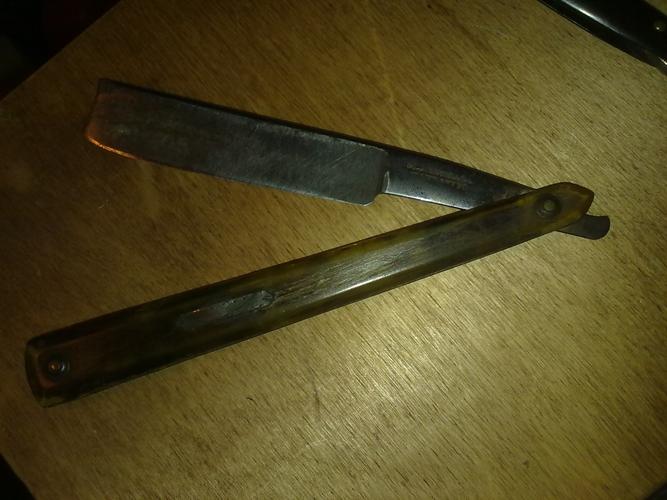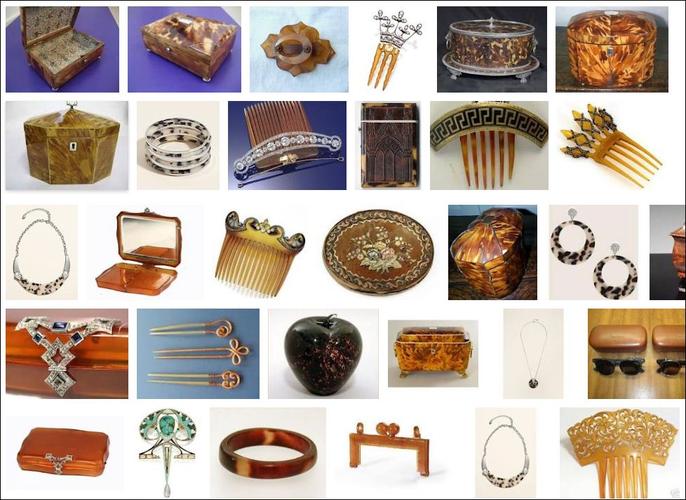Results 1 to 9 of 9
 14Likes
14Likes
Thread: Distinguishing turtle from horn...
-
08-24-2012, 08:40 PM #1
 Distinguishing turtle from horn...
Distinguishing turtle from horn...
Good evening Sirs,
I have just received this Clark & Hall Warranted STR8 from the beginning of XIX century.
At first I thought the handle was horn, but at the touch it feels slightly different, and more similar to the shell of my turtles. So I wonder: could it be turtle? Can somebody tell me how to distinguish between the two materials?
Thanks in advance,
Mauri
-
08-25-2012, 12:37 AM #2Senior Member



- Join Date
- Apr 2008
- Location
- Essex, UK
- Posts
- 3,816
Thanked: 3164
Both horn and tortoiseshell/turtle (it comes from the hawksbill sea turtle) share a similar composition - both are thermoplastic and both are similar to the compostion of fingernails - keratin, mineralised to some degree. Both horn and tortoiseshell smell the same if a hot pin is applied to them, like burnt hair (keratin again).
However, tortoiseshell is stronger and more robust and tightly-packed compared to horn. Old horn takes on a fibrous nature whereas old tortoiseshell just gets dull. It is said that nitric acid attacks tortoiseshell, but it is unaffected by hydrochloric acid, whereas hydrochloric acid softens horn. a bit of an extreme test, though!
Horn was made to look like shell by staining and mottling it with dyes and chemicals - it was called 'mockshell' but the mottling in mockshell is on and just below the surface (the cheaper varieties had it just on the surface - it was easily buffed off - the more expensive stuff had the mottling penetrating deeper. The mottling in tortoiseshell is right in the material, though, but to see this you would probably have to cut a section and polish it, so not a very satisfactory test.
In short, there is no easy way to tell the difference if the mockshell is a good example and in good condition.
Regards,
Neil
-
-
08-25-2012, 01:44 AM #3

I hear turtle tastes like chicken...
-
08-25-2012, 02:11 AM #4Just a guy with free time.

- Join Date
- Oct 2011
- Location
- Mid state Illinois
- Posts
- 1,448
Thanked: 247
Another thing, in addition to what Neil said: I've read, IIRC that tortoise shell darkens with age, while horn will not. I don't know how accurate I'm being, and kinda hoping somebody will second pipe in and say they remember it too. I remember seeing the pictures in a razor book. It had tortoise shell next to mottled horn, and it was really obvious with one right next to the other. The tortoise was a deep, dark, caramel color with dark blotches that were almost invisible, because the lighter parts had turned so dark. While the mottled horn scales were still very obviously light honey color, with mottling applied.
-
08-25-2012, 03:33 AM #5

Although it's far from scientific, real tortoise shell is quite dark with even darker blotches. Most of the faux tortoise shell is blonde horn with brown blotches. They are far too light in colour to be genuine tortise shell. It's also very rare to find genuine tortoise shell scales.
-
08-25-2012, 04:34 AM #6
-
08-25-2012, 04:41 AM #7

I have a Case Bros Springville ,NY that I believe has tortoise scales. Along the edges there were a couple of rough spots and I checked them with a 30x loupe. Doing some googling I found an article that said tortoise was heated and laminated to make into small items such as combs and razor scales. So upon examination it appears that the rough spots are the tortoise delaminating in spots. Not sure if this is correct but that is my story and I'm sticking to it.

-
08-25-2012, 08:59 AM #8Senior Member



- Join Date
- Apr 2008
- Location
- Essex, UK
- Posts
- 3,816
Thanked: 3164
Not so.
Tortoiseshell can be extremely dark, too dark to notice mottling, or a clear translucent yellow colour with little or no mottling - or anywhere between!
The hawksbill turtle most frequently produces a translucent shell with red-brown spots. The yellow type was called 'blonde' in the trade and the amber type 'demi-blonde' - blonde was the most expensive. Hawksbill turtles were used most of all (thicker shells) but two other species (green and loggerhead) could also be used. The green one was made into soup, too!
The shell comes from either the back (carapace) or the belly (plastron). Darker colours come from the carapace, lighter colours, including the clear unmottled yellow, from the belly.
Some pics of tortoiseshell, showing blonde, demi-blonde and some other colours:

Regards,
Neil
-
-
08-26-2012, 08:09 AM #9

If you think you may have horn stained to look like clear but mottled tortoiseshell, look at it with a lens and white paper bahind it, in extremely hard, directional lighting sich as a single unfrosted bulb several feet away. You ought to see the pattern casting a shadow, in a way quite different from the penetrating cloudiness of true tortoiseshell.
-
The Following User Says Thank You to Caledonian For This Useful Post:
Mauri (08-27-2012)



 LinkBack URL
LinkBack URL About LinkBacks
About LinkBacks






 Reply With Quote
Reply With Quote


